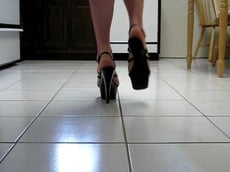
Large format ceramic and porcelain tile can provide a floor finish that is contemporary, beautiful, and easily maintained. In order to achieve a successful installation, it is important for a designer to understand the limitations as well as the capabilities of these materials. Today’s design trends favor larger format tile sizes and narrower grout joints, but what about the bonding pattern of the tile?
The tile industry has determined that large tiles laid in running bond, i.e. 50% offset, may result in increased lippage caused from the inherent warpage of the tile and the bonding pattern’s alignment of a tile’s high edge with the low edge of an adjacent tile. This potential for excessive large format tile lippage may be mitigated by increasing the minimum grout joint width, or it may be more simply mitigated by using a 33% offset (or less) in the bonding pattern rather than a 50% offset. This is clarified by ANSI A108:
ANSI A108.02.4.3.8.1 states:
“For running bond/brick joint patterns utilizing tiles (square or rectangular) with any side greater than 18 in., the grout joint shall be, on average, a minimum of 1/8 in. wide for rectified tiles and, on average, a minimum of 3/16 in. wide for calibrated (non-rectified) tiles. The grout joint width shall be increased over the minimum requirement by the amount of edge warpage on the longest edge of the actual tiles being installed.”
ANSI A108.02.4.3.8.2 states:
“For running bond/brick joint patterns utilizing tiles (square or rectangular) where the side being offset is greater than 18 in. (nominal dimension), the running bond offset will be a maximum of 33% unless otherwise specified by the tile manufacturer. If an offset greater than 33% is specified, specifier and owner must approve mock-up and lippage.”

This language accurately and appropriately cautions the designer about the potential pitfalls of running bond. However, the language in its current form has been determined by the ANSI A108 Accredited Standards Committee for Ceramic Tile to be too narrow. Other bonding patterns besides running bond can result in similar undesirable effects. Consider, for example, herringbone and basketweave. These common patterns also align a tile’s corner with an adjacent tile’s midpoint, potentially causing the same undesirable results. Additionally, certain large format tile is manufactured in shapes other than square and rectangle and are laid out with similar problematic joint alignment.
Consequently, an ad hoc subcommittee on offset bonding has been formed to develop new, broader language to be considered by the ANSI A108 Accredited Standards Committee for Ceramic Tile. Language under consideration, but not yet approved, is as follows:
“Care should be taken when installing any offset pattern (i.e. non-continuous grout joints), especially when using tiles greater than 15 inches on one side, due to the potential resulting proximity of a tile’s high edge with an adjacent tile’s low edge. It is recommended that the installer with an owner’s representative inspect the tile to ensure the intended pattern does not result in unacceptable lippage.”
Designers should develop an understanding of ANSI A108 and its commentary on bonding patterns, and work closely with suppliers of their specified tile, to determine the suitability of the specified tile and bonding pattern.
Scott Conwell, International Masonry Institute




